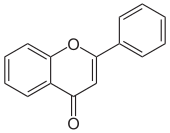


Flavonoids (or bioflavonoids; from the Latin word flavus, meaning yellow, their color in nature) are a class of polyphenolic secondary metabolites found in plants, and thus commonly consumed in the diets of humans.[1]
Chemically, flavonoids have the general structure of a 15-carbon skeleton, which consists of two phenyl rings (A and B) and a heterocyclic ring (C, the ring containing the embedded oxygen).[1][2] This carbon structure can be abbreviated C6-C3-C6. According to the IUPAC nomenclature,[3][4] they can be classified into:
- flavonoids or bioflavonoids
- isoflavonoids, derived from 3-phenylchromen-4-one (3-phenyl-1,4-benzopyrone) structure
- neoflavonoids, derived from 4-phenylcoumarin (4-phenyl-1,2-benzopyrone) structure
The three flavonoid classes above are all ketone-containing compounds and as such, anthoxanthins (flavones and flavonols).[1] This class was the first to be termed bioflavonoids. The terms flavonoid and bioflavonoid have also been more loosely used to describe non-ketone polyhydroxy polyphenol compounds, which are more specifically termed flavanoids. The three cycles or heterocycles in the flavonoid backbone are generally called ring A, B, and C.[2] Ring A usually shows a phloroglucinol substitution pattern.
- ^ a b c Delage B (November 2015). "Flavonoids". Linus Pauling Institute, Oregon State University, Corvallis, Oregon. Retrieved January 26, 2021.
- ^ a b de Souza Farias SA, da Costa KS, Martins JB (April 2021). "Analysis of Conformational, Structural, Magnetic, and Electronic Properties Related to Antioxidant Activity: Revisiting Flavan, Anthocyanidin, Flavanone, Flavonol, Isoflavone, Flavone, and Flavan-3-ol". ACS Omega. 6 (13): 8908–8918. doi:10.1021/acsomega.0c06156. PMC 8028018. PMID 33842761.
- ^ McNaught AD, Wilkinson A (1997), IUPAC Compendium of Chemical Terminology (2nd ed.), Oxford: Blackwell Scientific, doi:10.1351/goldbook.F02424, ISBN 978-0-9678550-9-7
- ^ Nič M, Jirát J, Košata B, Jenkins A, McNaught A, eds. (2009). "Flavonoids (isoflavonoids and neoflavonoids)". The Gold Book. doi:10.1351/goldbook. ISBN 978-0-9678550-9-7. Retrieved September 16, 2012.